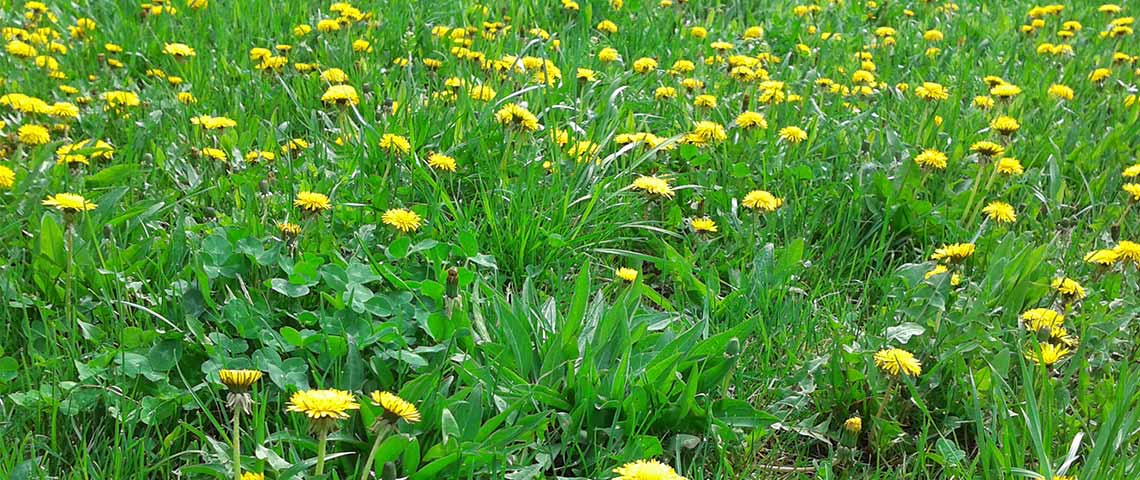5 Top Lawn Weeds You Can Do Without

Lawn weeds spoil the beauty of a lush, green lawn, but some weeds don't stop there. Aggressive weeds, like the top five that follow, spread quickly and choke out grass wherever they grow. Don't despair when weeds invade; take prompt, effective action instead. Kill difficult lawn weeds, protect your grass and keep your thick, beautiful lawn.
BITTERCRESS
An annual broadleaf weed, bittercress only lives a single year. But before it dies, it produces prolific seed to ensure a repeat next season. A common winter weed in moderate climates, this lawn weed germinates year-round in cool, moist conditions. What starts as a small, flat, green rosette quickly becomes a large mat of rounded leaflets. Thin flower stalks send up small, white flowers that produce numerous needlelike seed pods. When ripe pods burst, seeds fly several feet in all directions.

Bittercress is a common winter weed in moderate climates.
CLOVER
Erosion control specialists often use white clover for quick groundcover and extensive roots. Those same qualities make this perennial broadleaf weed and its strawberry-pink relative fast-moving, invasive lawn weeds. Able to flourish in undernourished soil, clover easily outcompetes weak grass. Large patches of small, rounded white and pink flowers and classic "three-leaf" clovers quickly form. This aggressive lawn weed comes back season after season, and its seed can survive in soil for many years.

Clover is an invasive lawn weed that easily outcompetes weak grass in undernourished soil.
CRABGRASS
Crabgrass seems to live forever, but it's actually an annual warm-season weed grass. Like bittercress, it completes its full life cycle in a single year, but it leaves lawn owners something to remember it by. A single crabgrass plant can generate up to 150,000 seeds. Germination starts in spring and continues all summer until temperatures get too warm. Low mowing won't prevent seed heads. This weed's coarse, crablike stems and leaves grow so low they avoid mower blades, even in very low lawns.

A single crabgrass plant can generate up to 150,000 seeds.
Photo credit: NY State IPM Program at Cornell University, CC BY 2.0.
DANDELION
Dandelions are broadleaf perennial weeds that produce fuzzy yellow flowers and white puffball seed heads on hollow, leafless stalks year after year. The plants grow in rosettes of serrated leaves and spread aggressively to form large masses in lawns. Long taproots beneath each plant can extend up to 18 inches deep. Attempts to pull dandelions usually fail; they spring back from broken roots vigorously. When puffy seed heads disperse, seeds can travel several miles on the wind.

When dandelion's puffy seed heads disperse, seeds can travel several miles on the wind.
NUTSEDGE
Also known as nutgrass, nutsedge isn't a grass or a broadleaf weed. This difficult lawn weed is a sedge, identified by its triangular stems. Its yellow-green grassy leaves and spiky yellow-brown flower heads stand out clearly in lawns. Nutsedge spreads by seeds, underground stems and underground tubers known as nutlets. One plant can form thousands of nutlets in a season. Nutlets can stay protected deep in soil for up to 10 years before finally coming forward to produce more nutsedge plants.

Nutsedge has yellow-green grassy leaves and spiky yellow-brown flower heads that stand out clearly in lawns.
Photo credit: NY State IPM Program at Cornell University, CC BY 2.0.
EFFECTIVE WEED TREATMENT AND CONTROL
Controlling these persistent lawn weeds and others requires killing these invaders, roots and all. Image Herbicides Crabgrass, Nutsedge & Weed Killer For Lawns Ready-To-Spray starts working on contact to kill tough weeds in established lawns all summer long. The ready-to-spray container attaches to a regular garden hose, automatically measuring and mixing as you spray. It delivers visible results in three to seven days and kills weeds completely within two to three weeks.
For best results, treat new weeds as they emerge from soil, when they're young, actively growing and still less than 3 inches tall. This stops these lawn pests before they can establish, set seed and spread on their own. Used as directed, Image Herbicides Crabgrass, Nutsedge & Weed Killer for Lawns Ready-To-Spray is guaranteed not to harm your lawn.*
To help your lawn grass stay at its competitive peak, follow these "good practices" as well:
- Take lawn soil samples every three to four years. Your lawn may need lime to balance soil pH and restore nutrient availability to grass.
- Maintain your lawn at the recommended height for your grass type. This promotes healthy growth and improves resistance to weeds and other pests.
- Water your lawn as needed to provide 1 inch of water per week from rain or irrigation. Water deeply to enhance resilience and encourage deep root growth.
- Feed your lawn regularly with high-quality lawn fertilizers. Healthy, well-fed grasses can stand up better to invading weeds.
- If you live in the South, use the best fire ant killer to prevent destructive fire ant mound damage to your lawn.
When unwelcome weeds turn up in your lawn, don't wait and watch them spread. Reclaim your turf with Image brand and Image Herbicides Crabgrass, Nutsedge & Weed Killer for Lawns Ready-To-Spray. You can kill lawn weeds — roots and all — and get back to a beautiful, healthy, weed-free lawn.
*Always read product labels thoroughly and follow instructions, including guidelines for specific lawn grass types.
Image is a registered trademark of Central Garden & Pet Company.
Sources:
1. UMass Extension Turf Program,
"Biology and Management of Crabgrass,"
University of Massachusetts Amherst, May 2011.
2. Roncoroni, J.,
"Dandelion,"
University of California Statewide Integrated Pest Management Program, January 2018.
3. Patton, A. and L. Beck,
"Yellow Nutsedge,"
Purdue University Extension.

